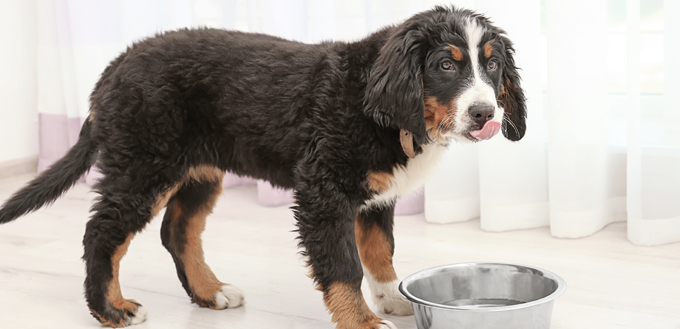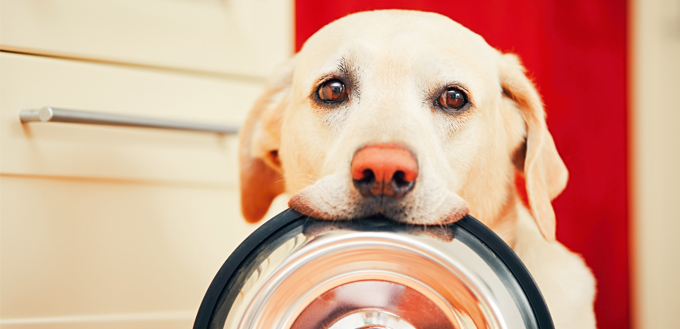Dogs and puppies are such little sweethearts. Their energy and sense of fun are one of the many reasons they are such a popular pet. But their vigour isn’t always ideal. Many puppies are impatient and nothing shows this more than when you try and feed them. They jump up, run around you and pounce on their dog food bowls, which, at best, is quite annoying, but at worst can become quite dangerous. Teaching your dog the important virtue of patience, or waiting, isn’t that difficult and is vitally important, especially in relation to food.

Related Post: Dog Bowls
Rude and Dangerous Behaviour
When our dogs get overexcited by their food, many owners object to the rudeness of their behaviour, and for good reason. They can become loud, hyperactive and might snatch their food so violently that it creates a mess all over their dog food mats. But, more importantly, teaching your dog to wait for their food has serious benefits for their development.
Impulse control is a crucial skill for a dog as is a step towards becoming safe and calm pets around strangers and children. Further evidence that your dog might need impulse control training might be if they are particularly violent with their toys. If you suspect your dog needs to improve their impulse training, your holy grail is the ‘wait’ command. Patience will benefit your dog in a variety of situations, from waiting before crossing a road to waiting while you attach their leash, and a great first step for teaching your dog to ‘wait’ is to teach them not to dive into their dog food bowls.
Training Your Dog To Wait
There are many ways to teach your dog to wait and understand the cue word ‘wait’. Here is one which is specific to understanding waiting for their bowl. It is a good method for training between meals.
- Get your dogs attention and show them a dog treat and put it into their empty bowl at waist height
- Keep the bowl out of reach and ask them to sit, but do not reward them for sitting
- Lower the bowl slowly and ask your dog to ‘wait’
- When your dog stops sitting, stand up and start again
- Repeat until you get closer to the floor
- Once you are able to reach the floor without them standing or lunging at you, let them have the treat
Your dog might need plenty of practice before they truly understand that it benefits them to wait, but gradually they will learn patience. But don’t worry if your dog doesn’t understand at first, there are other techniques you can try and further tips below to make sure your training technique is the best it could be.
Meal Time Training
Another great technique utilises meal times to teach your dog to wait for the food bowl, and for this method, you don’t need to have successfully trained your dog to understand the cue ‘sit’. There is nothing to stop you using both methods, but be careful you don’t overwork or overfeed your dog.
- Fill your dog’s bowl with around a quarter of their allotted mealtime dry dog food and hold it at your waist
- Lower the bowl slowly
- If your dog moves towards you and the bowl before the bowl is parallel with your knee, bring the bowl back to your waist
- If your dog successfully manages to wait until the knee, reward them with one of the pieces of food.
- Repeat until your dog is successful two or three times
- Start again, but now you should reward your dog when they wait until a few inches below your knee and pull up the food to your waist when they move in to eat
- Repeat until your dog is successful two or three times
- Start again, but add a few more inches below the knee.
- Repeat until you are able to put the bowl fully on the floor, take your hand away and stand up fully before they eat.
- Once you this behaviour is a success, you can start to add in the command word ‘wait’, so that your dog associates that word with waiting for their food. This will make training them to wait before they jump in the car, leave the house, cross the road or any other desired waiting behaviour much easier.
Tips
Training a dog isn’t as easy as some experts can make it look. It requires patience of your own, as well as hard work. So to help you make the most of your training sessions, here are some tips to help you teach your dog to wait before the gorge themselves:
- The methods above both use positive reinforcement, which is much more effective than your gut instinct to yell at your dog, a form of punishment, for being rude or aggressive. This is called negative reinforcement and doesn’t usually teach dogs what they have done wrong. It creates a slow learning process and can also encourage anxiety in pets, who are learning to live in fear of you, rather than important life skills.
- Make sure your dog is in the right mood for training. This means they should be hungry, calm and attentive.
- With both techniques, it might take a long time and you might find yourself having to bend up and down a lot. Don’t worry, this is normal. As long as you still have your dog’s calm attention, keep trying.
- While you obviously don’t want your dog to dive into their food, it is acceptable for them to watch the bowl intently as your practice, which might mean their head jerks up and down along with the bowl in anticipation. It is actually quite helpful as it means you have their full attention.
- Don’t confuse too many commands. If you have already started similar impulse control training techniques for other issues, such as crossing the road and are using ‘stay’ instead of ‘wait’, use the same command here. But be aware that ‘sit’ is different behaviour to ‘stay’ or ‘wait’. Choose your cue words carefully.
- Use a clicker for more efficient dog training. A clicker essentially means you can hone in on the behaviour that you are rewarding. Using just treats can cause a communication error as your dog might be exhibiting a new behaviour by the time you have taken the food from the bowl to give to them and that is the behaviour you will be reinforcing, rather than their patience. Get your dog to associate the training clicker with praise and reward, and soon enough you can use the clicker to tell them ‘good job’ immediately when they exhibit good behaviour
- Keep your other pets out of the room while you train. They might get confused and think the food is for them, or they might distract your dog. To keep your dog in the right frame of mind, make sure it is just you and them.
- End training on success, so if you’ve achieved something, then stop and try it again later. If your dog starts to look unhappy, frustrated, anxious, or confused, you might want to try on another day.

More Impulse Control Training
There are other means of impulse control training and your dog might not just be grabbing from their food bowl. If they are also over-enthusiastic when you feed them treats out of your hand, you might want to try this method of training.
- Hold the treat in a fist.
- If your dog tries to grab, say ‘Ouch!’ and move your hand out of reach
- Wait, then repeat
- When your dog is gently licking and nibbling at your hand, open your hand and give them the treat.
Similarly, you should teach your dog to understand cues like ‘drop it’ with a simple, but fun game. This will teach them not to be so possessive over their belongings.
- Offer your dog one of their less loved dog toys and ask them to ‘take it’ or ‘pick it up’
- After 30 seconds or more of playing with it, offer another toy of equal value to them and ask them to ‘drop’ the old toy and ‘pick up’ the new toy. You can use your own command words, but be consistent
- Repeatedly swap the toys until they manage to respond to the cues successfully 90% of the time
- Start again with two toys of higher value, but remember they must have equal value to one another.
- Make sure you make it a fun game, rather than a formal training exercise that needs treats and rewards.
Be Careful
If your dog is exhibiting serious impulse control and aggression surrounding their food and toys, often called being a ‘resource guarder’, then you should consider hiring a professional dog trainer as their behaviour could become dangerous. If you deny an aggressive dog their food, treats or toys, they might lash out. This makes training particularly vital as a resource guarder could one day turn their aggression to strangers and even children.
Sources:
- Debra Horwitz, DVM, Training Your Puppy to Come, Wait, and Follow, VCA Hospitals
- Stephanie Plummer, How to Train Your Dog to Wait for Food, Wag







